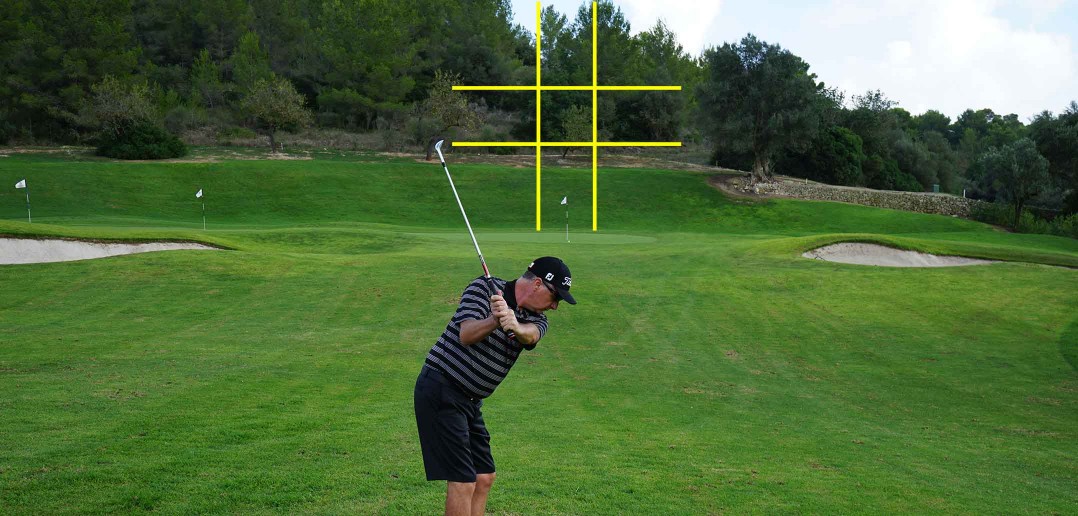This is a great game for developing and honing your shot making skills, and for quickly revealing your strengths and weaknesses – valuable information that you can use to guide your skill development and to make better choices out on the course.
We usually introduce this game to students as part of their wedge play training, but it’s also a great way to work on your long game skills.
How to Play
To play the 9 Shots game, first prepare by doing the following:
- Warm up as you normally would on the range and play a few solid full swing shots with a mid-iron. Play a few draws and fades to get a feel for your swing of the day – see Golf Wedge Play 109 – Technique: Working the Golf Ball.
- Pick a specific target within wedge play distance.
- Play a few straight shots to your target, making a note of the height that your standard shot flies. Find something to act as a reference, maybe a cloud or the top of a tree, and imagine a grid in the air, built around that reference point, through which you can see if you are playing shots high, medium or low, and a draw, straight shot or fade – see Figure 1.
Now it’s time to play:
- Now play a low draw to your target, the ball flying through the bottom-right section of your grid (for a right-handed golfer) and landing near the target.
- Count how many attempts it takes you to play this shot successfully, and record it on your 9 Shots Scorecard – see Figure 2.
- Repeat for a mid-draw and a high draw.
- Repeat for low-straight, mid-straight, and high-straight shots.
- Repeat for low-fade, mid-fade, and high-fade shots.
Print a scorecard for the 9 Shots game: ![]()
A successful straight shot is one that flies straight, goes through the correct section of your imaginary grid, and lands within 2 yards of your target.
A successful draw or fade is one that moves through the air as required, flying through the correct section of your imaginary grid, and lands within 4 yards of your target. A draw must land to the right of the target (for a right-handed golfer), and a fade must land to the left of the target, or that shot is a counted as a miss and you must try again.
Once you have successfully played all 9 shots, enter totals for each row and column on your 9 Shots Scorecard.
It is important that you perform your full pre- and post-shot routine for every shot. Read the conditions, and carefully determine the club required to “one hop and stop” the ball near the target each time. Take your time to visualise the shot, rehearse your swing, try the right amount and react to the target. Use your post-shot routine to actively build your self-image and learn from your mistakes.
Always record your score in your practice session log, you can use the scorecard above, and try to beat your best total score, and the best score for each row and column, each time you play this game. The competitive edge is crucial.
After you play, take the time to record your score and make notes in your practice session log of any shots that you found particularly difficult. Think about, and make a note of, what you can do to improve before the next time you play.
Analysing Your Score
If you’re working on your shot shaping technique, you may score very high numbers at first, don’t worry, keep at it and you will quickly see progress. Even the very best players in the world would struggle to score a perfect 9 – Tiger Woods is the only player that we’ve seen do this consistently.
You can use your score matrix to guide you in subsequent practice sessions, working on specific shot shapes that you struggled with.
In the score matrix shown in Figure 2, you can see that the golfer scored very well, but the weakest part of his game was the draw – he scored 10 points in that column, compared to 4 in the others. Hitting low shots may also need some practice.
You can also use this information out on the course. The golfer who played the score in Figure 2 may feel like he can draw the ball well, perhaps he enjoys this shot, but the score tells him that he has a less than 1 in 3 success rate with the draw, and so he may want to avoid these shots in competitive play until he’s put some work in.
The Long Game
When working on your shot making off the tee and in iron play, you can play the same game with your chosen club. We recommend that you use one club regularly so that you can gauge your progress, perhaps a 7 iron, and then use other clubs from time to time to test your skills.
With longer clubs, your target area for a successful shot should be larger, perhaps within 10 yards of a specific target on the range. Set a margin based on your current skill level and try to reduce it over time.
The rules for draws landing right of the target and fades landing left still apply.
This article is part of the Golf Loopy Score like a Champion series, the sensational new wedge play game improvement system that will help you to attack the pin from 120 yards and in. The improvements to your scores will be dramatic, and they will be permanent.






